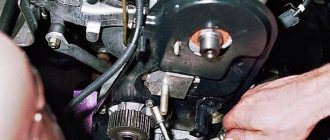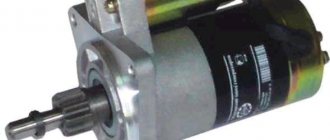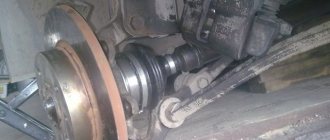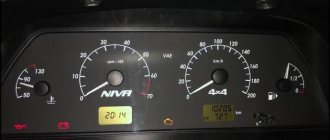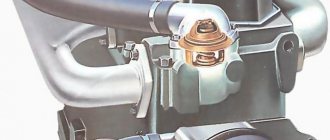The thermostat on cars VAZ 2113 VAZ 2114 is an element of the cooling system that discharges coolant to a large circle at a certain temperature.
The thermostat ensures that the engine runs correctly and does not get too hot. It is also responsible for warming up: if the thermostat is worn out and the fluid immediately comes out in a large circle, then the car takes a very long time to heat up (especially in winter), which means the car’s fuel consumption increases.
Over time, a lot more problems will emerge, because running the engine for a long time on a cold engine is very destructive, and driving on a cold engine is even worse. There is a lot of load on the engine, lubricant does not reach all parts well, etc.
If possible, in very cold weather (-25 and above, although -20 is already enough), we recommend not using the car at all if you want the engine to live a long enough life and not require major repairs in the near future.
Replacing the thermostat
If during the inspection it was determined that the malfunctions of the VAZ 2114 thermostat are serious, and it can no longer be used (this especially applies to the situation when the device jams “in a small circle”), then it should be replaced.
It is produced as follows:
- Place the machine on the site.
- Open the hood and remove the negative terminal from the battery.
- Remove the air filter.
- Open the expansion tank cap.
- Remove the drain plug and drain all the coolant from the system into a prepared container.
- Loosen the clamps securing the cooling hoses leading to the thermostat.
- Unscrew all fasteners holding the thermostat housing.
- Remove the hoses from the thermostat and remove the device itself (this is best done by gently rocking its body).
- Remove the old gasket and clean the seat.
- Install a new gasket.
- Install a new thermostat, coat all pipes with sealant and connect the cooling system hoses to it (they should first be checked for damage and cracks and, if necessary, replaced with new ones).
- Secure the new thermostat housing using studs and nuts.
- Close the drain hole with a plug and pour new coolant into the system.
- Reinstall the air filter and start the engine.
Immediately after completing the replacement, you should check the functionality of the new thermostat by checking the condition of the radiator pipes (as explained above), and also make sure that hot air is discharged evenly from the radiator.
This will show that there are no air pockets in the cooling system, and the machine is completely ready for operation without the risk of overheating of the power unit.
Why does this happen?
For what reasons does the thermostat break? Signs of malfunction are often caused by a violation of the integrity of the structure. Because wax is placed inside the housing, it leaks out and mixes with the coolant. Violation of tightness occurs due to poor-quality antifreeze or untimely replacement. As a result, the system is subject to corrosion processes. The tubes inside, as well as the thermostat, begin to rust. Due to corrosion, the friction force of the moving rod increases.
Design Features
A thermostat is a small mechanical valve. The device regulates and determines the temperature of the coolant in the engine system and is responsible for the quality of warming up the car engine. The structure consists of the following elements:
- frame;
- inlet pipe. Connects directly to the cooling system;
- wax ball;
- main valve Responsible for blocking the main circulation process;
- piston;
The thermostat regulates the temperature of the coolant in the engine
- bypass valve. If necessary, closes the small cooling circle;
- special spring to hold the portable valve;
- outlet pipe. Connects to a pump pumping cooled liquid;
- a spring holding the bypass valve;
- additional inlet pipe. The element is connected to the radiator.
This video will help you get acquainted with the principle of operation of the thermostat:
Types of modern thermostats
Today, car manufacturers equip engines with different thermostats. There are several main types of these useful structures:
- Electronically controlled device. Suitable for all operating modes of the power unit. Electronic devices are supplemented with a special heating resistance. Known for their efficiency and accuracy. Their use allows to reduce fuel consumption.
- Single valve. Reliable and durable unit. The majority of cars are equipped with a single-valve thermostat.
There are several main types of
two-valve automobile thermostats. One thermostat has two valves: the main and the secondary. The main one is used to circulate antifreeze in a large circle. The second, the so-called bypass valve, performs similar actions, only in a smaller circle. Two-valve thermostats are in demand in the CIS.
Two-stage. The design also provides two valves: large and small. It is recommended to install in a system with high coolant pressure.
It will be useful: How to remove a brake drum on a Renault Logan
Signs and causes of failure
Any malfunctions in the operation of the device have a detrimental effect on the operation of the entire vehicle. The main symptom and cause of the malfunction is considered to be corrosion. It gradually corrodes the locking pin and cylinder. A sign of a broken thermostat in this case is a pulsating, continuous flow of cooled liquid.
It does not matter what position the valve is in. Signs of a faulty thermostat also include:
- The lower pipe becomes warm within a few minutes of operation of the unit. The device is always open.
- The car engine quickly overheats. When a car engine overheats, the design pipes (lower and upper) are at the same temperature.
A faulty thermostat is indicated by engine overheating and several other indicators.
While the device is operating, the engine needle drops sharply and shows a temperature lower than normal. When the engine stops running, the needle reading increases. Staying in a closed position for a long time. In this case, the structure literally jams. The temperature on the instrument panel shows that it is boiling. After prolonged operation of the engine, the lower pipe remains cold.
Due to breakdowns, the car cannot start normally. You should understand why the thermostat is not working and find out the signs of unit failure as soon as possible. Violation of the temperature regime has a detrimental effect on the engine: it quickly wears out and becomes unusable.
How it works?
Any engine uses two circuits:
- Small.
- Big.
Both contain coolant. However, after the engine starts, it heats up only in a “small” circle. This way the motor will quickly reach its operating temperature, which, as is known, is 80-90 degrees Celsius. The small circle is the heat exchanger of the stove and the engine itself. The second circuit includes a radiator with pipes, which has a large cooling area. This radiator is located in front of the engine. Additionally, air intake is provided by a special impeller. This could be a viscous coupling or an electric fan. But the operation of these elements no longer depends on the thermostat (the temperature sensor or the crankshaft drive belt is used here).
coolant temperature
As you can see, the device has a simple operating principle. However, this mechanism sometimes fails. Signs of a malfunctioning thermostat installed on a Renault Logan are always accompanied by overheating. But first things first. So, below we will look at the main symptoms and signs of a thermostat malfunction.
Logan 1.6 has a copper thermostat. Its service life is quite long (10 years or more). But if it malfunctions, do not hesitate to replace it.
How to understand that the thermostat of the VAZ 2115, 2114, 2113, 2109 is faulty?
There are two reasons why you can understand that the thermostat on the VAZ 2115, 2114, 2113, 2109 is faulty:
- The car does not warm up.
- The car overheats and boils.
There are also two ways to check the thermostat:
- Check the removed thermostat for functionality.
- Check the thermostat without removing it from the car.
Let's take a closer look at each of the options.
How to check the removed thermostat of a VAZ 2115, 2114, 2113, 2109 for functionality?
In theory, everything is simple. Take a pan with cold water, a thermometer up to at least one hundred degrees and a thermostat. We put it all on the tile to warm up and wait... We wait until the water temperature reaches 85 degrees, at which point we begin to look at the main thermostat valve. At 87 degrees it should open. If it does not open or opened earlier, then the thermostat is faulty.
How to check the thermostat of VAZ 2115, 2114, 2113, 2109 without removing it from the car?
A prerequisite in this case is that the car must be cold. After starting the engine, grab the lower pipe coming from the radiator with your hands. Until the temperature reaches 80 degrees it should be completely cold. When it reaches 85 degrees, the tube should begin to warm up slowly. And when 90 degrees is reached, full circulation of hot coolant should begin (i.e. the valve is completely open). The lower tube should be hot.
It will be useful: Toyota avensis has been discontinued, can be replaced by auris...
It happens that immediately after starting the engine, when it has warmed up only 50 degrees, warm liquid begins to flow through the lower tube. This shouldn't happen either. This means that the valve is constantly open.
The principle of operation of the thermostat on the VAZ 2114
The constituent structure of the thermostat is a fairly simple mechanism that is suitable for distributing the movement of liquid over small and large cooling circles (this depends on the supply temperature).
Thermostat: 1 – inlet pipe (from the radiator); 2 – rubber insert; 3 - solid heat-sensitive filler; 4 – bypass valve spring; 5 – inlet pipe (from the engine); 6 – bypass valve; 7 - outlet pipe (to the pump); 8 - main valve spring; 9 - main valve; 10 – pipe (from the expansion tank); 11 – piston.
A simple standard class 2114 thermostat, which is installed directly at the factory, consists of the following types of spare parts:
Thermostat device
- frame;
- bypass valve spring;
- bypass valve;
- main valve spring;
- main valve;
- pipes;
- piston with holder;
- temperature sensitive element.
Thermostat operating principle
- The temperature-sensitive element gives a signal to start the operation of this thermostat.
- If the main valve is closed, then after the motor starts running, the liquid in the system heats up and begins to move in a smaller circle.
- The liquid passes through the thermostat device and heats the sensitive element (it promotes expansion, thereby causing pressure on the valve).
- When the coolant is heated to the desired point (87 degrees), the valve begins to open little by little, and the coolant is gradually placed in a larger circle.
- If the heating of the coolant reaches 102 degrees, the valve will open completely and the fluid will circulate through the radiator.
- Consequently, after the machine’s engine stops operating, the liquid will begin to cool, and the temperature-sensitive element will compress and the valve will return to its initial position due to the return spring.
- It may happen that due to wear or damage (in extreme cases, factory defects), the VAZ 2114 thermostat becomes stuck in some position.
- Accordingly, the car engine may take a very long time to warm up, or, on the contrary, the engine overheats, which is a dangerous sign.
- Overheating of the motor can lead to massive damage, even self-destruction of the engine. In this case, major repairs will have to be carried out.
Why do sensors in refrigerators break?
There are not many reasons why thermal detectors fail. The main thing is its natural wear and tear - any part eventually exhausts its reserves and needs to be replaced.
A refrigerator temperature sensor is not very expensive. Someone might try to argue with this, saying that for such and such a refrigerator, this device costs a lot of money! Let me object - replacing a temperature detector, which costs that “a lot of money,” will, in any case, cost you less than buying a new refrigerator. It is much more profitable to recognize the breakdown of the analyzer in time and replace it, even for 2, 3, 4 thousand, than to let this moment take its course and subsequently shell out ten thousand to replace the compressor or even more to buy a new refrigerator.
So, before you question the claim that thermal sensors are inexpensive, check how much you will have to pay if a broken detector causes other systems to fail.
Another reason may be a voltage drop in the operating network. Like any other electrical appliance, a temperature sensor can burn out if the wiring in the apartment is poor or there are network malfunctions, and the sockets in the room are not very good.
There are other reasons, but they are not so frequent and therefore you can not focus on them (mechanical damage, manufacturing defects, etc.)
Replacing the thermostat VAZ 2110, 2114, 2107, 2109
Before you start replacing your thermostat, you can save a little money. In the summer, when the air temperature does not have a detrimental effect on the car engine, you can slightly “upgrade” the damaged thermostat and save the engine from overheating. If the valve does not open, the insides of the thermostat are completely pulled out, and it becomes the most common adapter for pipes. This option is perfect for those who do not yet have the opportunity to install a new part. The only disadvantage of this method is that it takes a long time to warm up the engine, especially if you are late for work. In winter, of course, this will be especially important.
Now about the replacement. The replacement procedure for a front-wheel drive car and a rear-wheel drive car is performed almost the same - the coolant is drained, the clamps are unscrewed and the old thermostat is removed. A new part is installed in its place. Now let's look at this video in detail for each of the cars.
VAZ 2107
If the radiator is an old model, then place any container of sufficiently large volume under it, disconnect the two wires from the temperature sensor located on the drain plug and unscrew the plug. In the new type of radiator, the sensor is located in a different place, so it will be enough to unscrew the special tap on the radiator. Wait until the coolant drains from the radiator and move the container under the engine. On the engine itself, unscrew the drain bolt and wait until the liquid drains from the engine. After this, unscrew the thermostat mounting clamps and pull out the pipes. The new thermostat at the connection points is lubricated with automotive sealant and mounted in place of the old one. Further assembly occurs in reverse order. Remember one thing - on a Zhiguli, first of all, antifreeze is poured into the radiator, and then into the expansion tank. This will help avoid unnecessary air pockets.
VAZ 2109
All the steps listed below are the same for the VAZ 2114 and VAZ 2110. As on the “seven”, we place the container under the radiator and unscrew the tap on it. The location of the tap may vary depending on the radiator brand. As soon as the liquid is drained, we move the container under the engine and begin to drain the antifreeze from the engine. Then, in the same way, unscrew the clamps securing the pipes to the thermostat and remove the latter. Don’t forget to also apply sealant to the joints and, after assembly, add coolant. This time, the liquid is poured only into the expansion tank.
That's all. That's all you need to know about the thermostat. Monitor the coolant temperature frequently and replace the faulty unit in a timely manner.
Repair and replacement
If the thermostat is clogged, you can try to wash or clean it. This limits the possibilities for repairing a faulty thermostat. In some cases, in the summer you can drive without a thermostat at all. Often, this is done when the radiator of the cooling system is quite clogged. But, this solution only works in the summer.
The thermostat on a car is not a universal device, and therefore, to replace it, you need to select a product that is suitable specifically for a specific car model.
And of course, you shouldn’t neglect thermostat breakdowns. Especially when it remains closed when access to a large cooling circle needs to be opened.
Both rapid engine overheating and a long period of reaching operating temperature can have the same cause - a malfunctioning thermostat. This small but very important device is responsible for regulating the circulation of coolant in the cooling system. Its function is to ensure quick warm-up of a cold engine, as well as to prevent overheating of the engine operating in optimal mode.
In order to make sure that malfunctions in the cooling system are due to a malfunction of the thermostat, there are several ways to check its performance. Typically, the thermostat is located in the space between the engine and the radiator, and therefore, when using methods for checking it directly at the installation site, you should be careful not to get burned on hot elements. Methods for checking the operation of a thermostat are based on the principle of its operation. They consist in the fact that the device opens and closes the pipeline valve, ensuring the circulation of coolant either in a large circle (that is, through the radiator) or in a small one.
The first method is to let the engine run for 2-3 minutes and then carefully feel with your hand the hose that goes from the thermostat to the radiator. If the hose is cold, then everything is fine.
If it is warm, it means the valve is not closed tightly and the engine will take a long time to heat up to operating temperature. This circumstance leads to excessive fuel consumption. Next, you should let the engine warm up to operating temperature, that is, 85-90 degrees. After this, again feel the pipe connecting the thermostat to the radiator. It should be hot. If it stays cold, the thermostat is stuck closed. In this case, the engine may overheat, since the coolant is not able to circulate through the large circuit. The second method is similar to the first, but simpler. You need to start the car and let the engine warm up to operating temperature. After this, you need to carefully feel the upper hose leading to the radiator and the lower hose leading from the radiator. If the top hose is hot and the bottom hose is cold, then the thermostat is faulty because it is not circulating coolant through the large circuit. The next method is to check the thermostat at home. Before checking the thermostat using this method, allow the engine to cool and drain the coolant. The thermostat is removed, placed in any suitable container and filled with water. The water is heated on the stove until it boils. The malfunction is determined visually. If the valve has opened, then the thermostat is working; if not, it’s time to change it. The fact is that artificial wax is placed inside the cylinder in the thermostat, which begins to melt at a temperature of 82°C. As the wax expands, it pushes out the pin, which opens the valve. When the wax cools, the pin slides back.
Recommendations and tips
Often, costly breakdowns occur as a result of improper operation of equipment. Let's look at some tips from experts that will extend the life of the unit.
If due to negligence the refrigerator was turned off, do not rush to turn it on, you need to wait a while and then start it up. After defrosting, you need to give the chambers time to cool and then load the food. To ensure careful operation of the engine, you should not set the maximum temperature; it is enough to set the knob to the middle for the unit to operate efficiently. Do not block the evaporator with products; disruption of its operation will lead to more global breakdowns. It is forbidden to chip off ice during defrosting. For a faster process, it is better to use warm water. It is worth storing light foods in the refrigerator door to protect the rubber seal from wear. Install the refrigeration unit away from heating appliances. If the unit breaks down, contact a specialist. By following all the recommendations of the specialist, you can avoid problems with the breakdown of the refrigerator.
So, you can find out the reason for the malfunction of the thermostat in the refrigerator yourself, while having only basic knowledge and understanding of the refrigerator’s structure. But if a malfunction is detected, it is better to contact a technician who is guaranteed to fix the problem without harm to other parts.
Ways to check an element
You can check the operation of the thermostat yourself directly in the car. In the vast majority of cases, such diagnostics give reliable results. You need to start checking when the engine has completely cooled down: start it and periodically feel the lower part of the radiator and the pipe extending from the bottom back to the engine.
The serviceability of the thermostat is determined by the following signs:
- at the initial stage of warming up, the radiator and the pipes suitable for it are completely cold;
- at an antifreeze temperature of 40–60 °C, the upper supply hose begins to warm up, the lower one remains cold;
- when the antifreeze heats up to 90–95 °C, the entire area of the heat exchanger and the lower pipe become hot, which indicates the opening of the damper and the movement of liquid along a large circuit.
It is recommended to carry out diagnostics until the sensor is triggered and the fan automatically turns on.
Deviations from the norm are interpreted as follows:
- If the inlet and outlet pipes together with the radiator immediately warm up, the thermostat is stuck in the open position. Antifreeze initially flows in a large circle, hence the heating.
- When the temperature reaches 90 °C, the bottom of the heat exchanger and the outgoing hose remain cold - the thermoelement damper is tightly closed, the part has become unusable.
- When the top of the radiator is hot and the bottom is slightly warm, the thermostat is stuck half-closed.
Unlike the first two points, the last conclusion requires mandatory confirmation. It is quite difficult to make a clear diagnosis when the coolant is divided into two streams moving along different circuits. Uneven heating of the heat exchanger fins, turning on of the fan and temperature surges are indirect signs. Symptoms of an air lock in the cooling system appear similarly.
To clearly check the functionality of the thermostat, it will have to be removed from the car. Disassembly and diagnostics are performed in the following order:
- Let the engine cool and drain the antifreeze - first from the cylinder block, then from the radiator. It is more convenient to empty the system into a wide container with low sides.
- Loosen the clamps securing the pipes to the thermostat. Disable them and remove the element.
- Inspect the part for a slightly open damper. If a malfunction is detected, further checking is pointless - you need to buy and install a new spare part.
- Heat a pan of water on the stove. When its temperature approaches boiling, lower the thermostat into the container and watch the damper. It should open without delay.
- Remove the part from the pan. When cooled, the thermoelement should immediately close the passage.
Reminder. After draining the cooling system, immediately disconnect the throttle body heating pipe. When you start pouring antifreeze back in, air will escape through the removed hose.
If during the inspection it turns out that the damper does not work or is jammed, the part must be replaced, since it cannot be repaired. Considering the large number of fakes on the auto parts market, you can first test a new thermostat in a store. Close the outlet pipe with your finger and try to blow air through the inlet pipe. A hermetically sealed damper will prevent this from happening.
Retest the new part at home by immersing it in a pan of boiling water. If the heat-sensitive mechanism does not work, return the defective part to the store or exchange it for another one.
Ways to solve problems
Possible solutions to the problem include:
1. If the coolant temperature exceeds the norm (provided the thermostat is working and it is correctly selected), it is necessary to replace the device, but with a higher opening temperature. As a rule, this step is recommended for motorists who operate cars in the mountains and in regions with hot climates.
2. When opening the thermostat late, it is important to ensure that there are no plugs and that the system is completely filled. If the problem is caused by a plug (coolant stagnation), then the best solution is to make a small hole in the plate (2-3 mm). As a result, the coolant flow around the thermostat is normalized, and the engine warm-up time increases.
3. Early opening of the thermostat is possible due to excessive pressure in the system. Zones of different pressure often appear around the device, which leads to its early operation. There are several reasons:
- failure of the cooling system;
- The thermostat spring has weakened;
- The engine runs at higher speeds during the warm-up period.
4. The engine takes too long to warm up.
- incomplete closing of the thermostat;
- violation of the integrity of the valve plate (for example, a gap has appeared);
- Incorrect position (possibly changing the location of the air valve).
5. The engine heats up above normal even in a situation where the thermostat is fully open:
- traffic jams or low coolant level;
- failure of the radiator (clogging of its cells);
- failure of the cooling pump or fan;
- contamination of the cooling system.
When to change: signs of thermal switch failure
Abstract symptoms can indicate the nature of the disease that has befallen the thermostat:
Stuck in open position (coolant constantly circulates through radiator)
In cold weather, the engine does not heat up well, and at extreme city speeds the coolant temperature drops. Let's say it's -15°C outside, the coolant at idle has warmed up to 70°C, we're driving on a multi-lane road, moving at a speed of 60 km/h, and the temperature gauge needle is either standing still or going down. Fuel consumption increases noticeably (+ 1-2 liters per 100 km)
The wedge is in the closed position (antifreeze moves along the jacket and heater radiator, bypassing the main heat exchanger). There will be no cooling and overheating is inevitable in summer. The fact is clearly clarified by the thermometer needle running upward when the cooling fan is on. Additionally, the “brains” indicate a problem in the form of an illuminated Check Engine icon. Final stop at an intermediate position. Prolonged heating + overheating in hot weather. Slight increase in appetite (within 1 l/100 km)
Fuel consumption increases noticeably (+ 1-2 liters per 100 km). The wedge is in the closed position (antifreeze moves along the jacket and heater radiator, bypassing the main heat exchanger). There will be no cooling and overheating is inevitable in summer. The fact is clearly clarified by the thermometer needle running upward when the cooling fan is on. Additionally, the “brains” indicate a problem in the form of an illuminated Check Engine icon. Final stop at an intermediate position. Prolonged heating + overheating in hot weather. Slight increase in appetite (within 1 l/100 km).
It is impossible to close a large circle tightly, while the rod moves and the full opening occurs. There is no wedge. This is prevented by deposits accumulated as a result of untimely change of antifreeze, mixing coolant of different classes (for example, on a Hyundai Solaris, antifreeze can only be mixed with G11), and the use of cheap or counterfeit fluids. The fact can be revealed in warm weather only through tubes. In winter, pollution will be indicated by a reluctant rise in temperature from 70°C to 90-95°C when driving on the highway, but in the city there will be no problems with warming up. Seeing such a picture, those who like to cover the radiator grille with cardboard often persuade the owner to insulate the front end. This is definitely useful in cold weather.
Replacing the VAZ 2114 thermostat, do it yourself
Before replacing your thermostat, purchase a new unit. Please note that savings in this matter may result in even greater costs. Valve problems can cause the engine to overheat and fail.
In such a situation, the costs will be much higher
This is why it is so important to buy a reliable thermostat for the VAZ 2114. Which is better? Here you should focus on the manufacturer and buy parts only in trusted stores or from a car dealer
Before starting work, prepare everything you need - sealant, a set of tools, a new device, a repair kit and new coolant. The algorithm of actions is as follows:
Drive into the pit (alternatively, you can use an overpass). If there is neither one nor the other, then you can work on a flat viewing platform.
Turn off the engine, raise the handbrake and make sure that the car engine has cooled down and the pipes are no longer hot. This is necessary primarily for safety.
Unscrew the drain valve at the bottom of the radiator and drain antifreeze or antifreeze into a pre-prepared container.
Note! It is highly not recommended to refill coolant even if you have recently replaced it. If you still use old liquid, let it settle thoroughly so that all the dirt settles to the bottom.
While the antifreeze or antifreeze is draining, unscrew the air filter, or rather its housing. To do this, just unscrew a couple of bolts and unscrew the clamp of the air duct pipe and pull out the connector from the mass air flow sensor (MAF). Field of which it can be dismantled.
Take a screwdriver and use it to loosen the main clamps on the pipes that go to the thermostat. Discard the pipes. Be careful when doing this - there may be some liquid left inside.
Using a hexagon, unscrew the three bolts that secure the thermostat and remove it along with the seal, as shown in the photo.
Thoroughly clean, wipe and lubricate the joint with sealant, install the O-ring and gasket.
Purpose and design of the device
The thermostat is one of the main components of the car’s cooling system and serves to redirect fluid to the small and large circulation circles. Thanks to this, the coolant actively takes heat from the engine (which is formed during its operation as a result of combustion of the fuel mixture and friction of moving parts) and, at the same time, does not overheat itself.
Thermostat operation of VAZ 2114
Structurally, the thermostat is a cast housing with three pipes:
- input - from the engine;
- input - from the main radiator;
- on weekends - to the water pump (pump).
Inside the body itself there is a valve, which is activated by a black heat-sensitive compound. When heated above a certain temperature, it expands greatly, puts pressure on the valve and displaces it, allowing the coolant access to a large circle.
Until the engine is warmed up, and, accordingly, the antifreeze has not reached the required temperature (87 C), the thermostat valve is in a completely closed state, and all the liquid circulates only through a small circuit.
Thermostat device VAZ 2114
Starting at a temperature of 88 C, the valve opens slightly, distributing coolant between both circulation circles. When antifreeze boils (at a temperature of 102 C), the valve opens to the maximum, shifting by 8 mm and redirecting all the coolant to a large circle.
It is easy to guess that if the VAZ 2114 thermostat is jammed and does not allow fluid to flow to a large circuit, then this situation can very quickly cause the engine to overheat and fail due to the lack of normal cooling.
It is precisely because of such a high risk of engine damage that you should not put off problems with the cooling system “for later”, but, on the contrary, you should immediately begin troubleshooting.
Operating principle
The operating principle of the KAMAZ thermostat is also no different. The difference is the engine cooling principle. The system works as follows:
- Cold coolant, after the engine starts, circulates through the channels of the power unit, pumped into the system by a water pump.
- At this time, both valves are closed by large bowls, only small bowls are open. The valve is designed so that the small bowls have a factory seat clearance.
- Initially, the left cylinder block is heated, and after it the antifreeze flows to the right side.
- After the antifreeze temperature has reached a threshold of 80 degrees, the small bowls close. Large bowls are opened. This occurs due to the heating and melting of the mixture of wax and aluminum in the thermoelement bulb. Due to melting, the pressure on the rods increases, they open, closing the passage channels with small locking bowls.
- The liquid opens the way to the radiator for cooling and temperature stabilization.
This process is repeated as the load on the engine increases, when operating modes and engine speed change.
This system allows you to quickly and evenly warm up both cylinder blocks of the power unit.
Modern KamAZ EURO-4 vehicles are equipped with more advanced thermostats. They received an addition in the form of an electrical thermistor. The on-board computer regulates the temperature and timing of valve opening by heating this element. This is necessary to quickly cool the liquid when heavy loads are placed on the engine.
These cars also received fans for additional cooling. During operation, the engine temperature can cross the threshold of 97 degrees. To cool such a volume of antifreeze, manufacturers equipped an electric fan with a temperature sensor. It automatically operates to activate an additional cooling mechanism.
Replacement or repair
Of course, it is possible to repair a broken device, but is it really that effective? If you consider the repair option, it is recommended that it be carried out exclusively in the field if you have the necessary tools. If the valve is not working, you can try to clean it in order to get to your destination. After this, it is recommended to immediately replace it.
The thermostat on the VAZ 2114 is a consumable item, the cost of which is not so high to try to repair it. Purchasing a new device guarantees its long service life, while a refurbished device may break down after just a few days. Therefore, in the event of a breakdown, it is recommended to install an analogue, even within 500 rubles, which can definitely last at least six months to a year.
Results
When the thermostat fails, the functioning of the refrigerator is completely disrupted. The motor-compressor either works non-stop and ice forms in the chambers, or vice versa - the temperature in the compartment does not decrease. With such “symptoms”, it is necessary to immediately replace the temperature sensor, since if the problem is ignored, more serious damage may occur, which will not be so easy to fix.
The process of replacing a faulty temperature regulator is not too complicated and can be done independently, without calling a refrigerator repair specialist. But, this statement is true only in the case of older models and devices with an electromechanical control type. If there are electronic control modules, it is not advisable to try to replace the thermostat yourself, as this can lead to more serious damage to the refrigeration equipment.
I recommend to read:
- Video on replacing the thermostat of the Atlant refrigerator - Video: replacing the thermostat on the Atlant refrigerator https://www.youtube.com/watch?v=r04yaJ4Qzqo Video: refrigerator Atlant MXM 1733 - replacing the thermostat https://www.youtube.com/watch? v=GGyC3IhJCw4 Video: replacement…
- How can you check the thermostat (thermostat, thermostat, temperature sensor) of a household refrigerator? The refrigerator thermostat is a relay that, based on the degree of cooling of the chambers, sends a signal to start or stop the compressor motor. The malfunction of this...
- Replacing the thermostat in Atlant refrigerators with your own hands - Replacing the thermostat with your own hands will not take much time. For example, let’s take a refrigerator of the Atlant brand: We determine where the necessary part is located. In the old...
- LED light bulb in the refrigerator: how to select and replace a spare part - The refrigerator is the most necessary item in the house, its malfunction even for a short time causes a lot of inconvenience. One of the breakdowns that can happen to it is...
- Do-it-yourself diagnostics of the thermostat of Atlant refrigerators - Checking the functionality of the thermostat of the Atlant refrigerator with your own hands If the thermostat fails, this does not mean that the refrigerator will immediately stop working. However…
- Video on replacing the compressor of the Atlant refrigerator - Video: replacing the compressor of the Atlant refrigerator https://www.youtube.com/watch?v=27dg9be0_NM Video: repairing the Atlant refrigerator - replacing the compressor https://www.youtube.com/watch?v= dX75XGfCDfo Video:…
- Video on replacing a light bulb in an Atlant refrigerator - Video: replacing a light bulb in an Atlant refrigerator https://www.youtube.com/watch?v=YtH97-NpXMg Video: replacing a light bulb in an Atlant refrigerator https://www.youtube.com/watch? v=CImKojAvFFE Video: how to replace a light bulb in...
Thermostat VAZ 2115: Replacement, check where it is located
A thermostat is a sensor designed to maintain a certain temperature. The thermostat blocks the path of antifreeze or any other coolant into the radiator until the engine reaches a certain operating temperature. The operating temperature of the engine is considered to be 90 degrees. The thermostat opens the coolant path at 95 degrees Celsius. Thanks to the thermostat, the engine spends less time warming up to operating temperature. It follows that the thermostat saves your pennies in your pocket and protects the environment. And it is located between the radiator and the engine.
Table of contents
Replacement How to check Which one is better to put Where is it located What does it look like
Replacement
First of all, you need to check whether the thermostat is really not working. We do the following:
1. start the car and feel the lower radiator pipe, it should be cold;
2. wait until the engine warms up to a temperature of 80-85 degrees and feel the pipe again, it should become warm.
Let's move on to the process of removing the thermostat. First, drain the coolant (you can only drain it from the radiator). Now loosen the hose clamps that are attached to the thermostat and remove them.
Then we remove the thermostat from the VAZ 2115.
To check if the thermostat is working, immerse it in water and start heating it; when the water temperature reaches 83-87 degrees, you should see the valve begin to open. If the valve stays still, the thermostat is faulty.
After installing the new thermostat, be sure to refill the coolant.
How to check
It is very easy to check the operation of the thermostat without removing it from the car. It is enough to start the cooled engine and check the temperature of the radiator pipes. In normal mode, when the engine is running, for some time after starting, only the upper radiator pipe will heat up slightly, and when the threshold value is reached, the lower pipe will also heat up sharply. This is evidence of normal valve operation. If heating of both radiator pipes begins simultaneously, this indicates that it is not functioning properly; most likely, the valve is constantly open.
The constantly open thermostat valve allows you to easily reach the nearest service station or spare parts store. It is much worse if the thermostat gets stuck closed, as there is a serious risk of engine overheating. Sometimes tapping on the thermostat body helps for a short time, but if the valve cannot budge, it should be removed or bent with a screwdriver. The thermostat must be replaced in the nearest locality.
Which one is better to put
It will also fit with 099 and 09, and with 083 and 093. It’s not a matter of VAZ models, the fact that components from one model fit another is a normal phenomenon for many manufacturers.
You need to buy a thermostat based on only a few things.
This is the metal from which the thermostat is made; preference should be given to stainless steel,
or brass and the second criterion is not to take Chinese spare parts under any circumstances, even if they are given away for free.
There is no option to check the thermostat while standing at the counter.
Many citizens begin to put pressure on the valve for some reason, apparently they want to check how the “spring” works, but there is no spring there, there is a special spiral made of a special material that operates only at a certain temperature.
If the seller has hot water, then lower the thermostat into the water and check the smooth movement of the rod.
Although, to be honest, it’s unlikely that the seller needs this.
Conclusion: pay attention to the metal first. Secondly to the country of manufacture, VAZ 2115 is a Russian car
Where is
It is located under the air filter housing on injection cars, but on carburetor Samara 2 (namely, the first VAZ 2115 were produced for a couple of years in a carburetor version), it is located exactly there, but the housing on them has simply been moved to a slightly different place, so it is no longer necessary on the carburetor It doesn’t take much trouble to remove the housing, but I just threw off the high-voltage wires and started working, but it doesn’t take long to remove the housing and on the injector it 100% needs to be removed to get to the thermostat, and after the housing is put aside, you will immediately see the thermostat is not armed it will even be visible to the eye (For clarity, it is indicated in the photo below with a red arrow) and next to it there is also a battery (indicated by a blue arrow) so that you understand 100% where it is and do not lose sight of it.
How to check the thermostat without removing it from the car? Signs of a bad thermostat
The thermostat is a small part in the mechanism of an internal combustion engine that is responsible for the operation of the cooling system. When this component stops working, thick accumulations of steam begin to emerge from under the hood of the vehicle, a similar picture can often be seen in various films and TV series.
The thermostat mechanically transfers flows of cooled liquid at different temperatures through the cooling system. It works in a large circle when the engine overheats - passing through the radiator, and in a small circle when the engine is cold - bypassing it. If this part does not work correctly, then in the cold season the stove freezes and it is impossible to warm up the car interior. There is a thermostat in both a used car and a new one, if they use a closed version of the liquid cooling system with forced circulation of liquid at a low temperature. The principle of operation of the part is identical for all cars, regardless of the country of manufacture.
Thermostat operating principle
Its main component is a mechanical valve, which begins to work under the influence of a clear mechanism. The hermetically sealed body of the device contains a special heat-sensitive wax, which, under the influence of high temperatures, begins to melt and increase in volume, thereby squeezing the rubber chamber. In turn, the chamber begins to push out a chrome-plated metal rod, which operates the valves.
When the engine starts, the thermostat remains closed so that antifreeze cannot get into the radiator and cool down. During this period of time, it moves along a small circle of the cooling system and cools the heating engine. When the liquid temperature reaches 90 °C, the engine has accelerated to the required mode; if it is above 90 °C, it will begin to overheat, so the antifreeze needs to get rid of the heat and it goes into high gear.
This principle of operation is very simple, but when the integrity of the structure is not respected, the wax can leak out due to the use of low-quality antifreeze (antifreeze) or corrosion processes, which will lead to an increase in the friction force of the moving rod.

